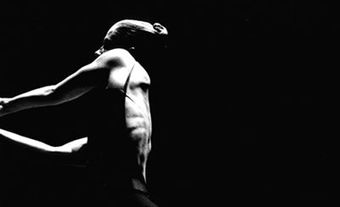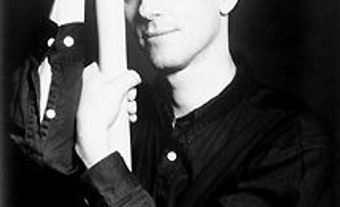Photography
After studying literature at the Université de Montréal (1991–92) and theatre at the Neighborhood Playhouse School of the Theatre in New York (1995), Ève K. Tremblay obtained a Bachelor of Fine Arts with a major in photography (1997–2000) from Concordia University in Montréal. Since the beginning of her career as an artist, she has adopted an approach that is both autobiographical and inspired by literary fiction. In her photography series L’éducation sentimentale (2000), whose title refers to Gustave Flaubert’s novel of the same name, the artist depicts young girls wearing school uniforms in various solitary and introspective situations that sometimes evoke uncomfortable experiences of initiation. These photos are no doubt inspired by the contrast between Tremblay’s teenage years attending a private college(Collège Notre-Dame in Montréal)and the bohemian childhood she spent in the workshop of her ceramicist-sculptorfather, Alain-Marie Tremblay.
In her photographic series Unmanifested Still Films (2006), Tremblay presents photos shot on film sets, combining stillness and movement both in the image and in time — a reality of film’s technical processes and of cinematic fiction. The way the scene is perceived through the eye of the camera collides with the looks exchanged within and outside of the framed image. In her series Postures scientifiques (2005–06), Tremblay photographs scientists immersed in conducting experiments. Generally photographing them from behind, she captures various curvatures of the spine that evoke concentration, expectation and reflection, while denying audiences the opportunity to fully understand the work being carried out, as it remains hidden by the anonymous figures absorbed in their tasks.
In 2003, Tremblay collaborated with artist Michel de Broin on the photographic series Honeymoons. In it, the two artists explore the physical, personal and dreamlikeencounters of two bodies, two lovers, occupying a particular space.
Becoming Fahrenheit 451
Ève K. Tremblay has devoted many years of her career to revisiting Ray Bradbury’s novel Fahrenheit 451 and to reflecting on its numerous underlying themes, especially neuroscience, mnemonics and philosophy. For her lengthy project Becoming Fahrenheit 451, she spent several months memorizing sections of the book and using photography and video to document her process. These documentation materials allow viewers to follow her professional and personal journey through various locales, various European and North American cities, and various collaborations that helped Tremblay in her memorization process. As part of this immense project, the artist performed EKTBF451/EKTFF451 (Ève K. Tremblay Becoming Fahrenheit 451/Ève K. Tremblay Forgetting Fahrenheit 451) in many venues between 2007 and 2013. During these live performances in exhibition spaces, she staged a mise en abyme of her work by enacting the creative and mnemonic process. Lying on the floor while an associate holds her copy of the book, Tremblay rehearses and learns her lines, receives corrections and reflects on the project’s challenges and progression. The memorization process itself becomes an essential element of both the artistic process and the exhibit. Furthermore, the artist’s copy of the book — heavily annotated, highlighted, underlined and photocopied — has frequently been exhibited over the years and has become an evolving work of art. This book, entitled Very Used Pages Memo Fahrenheit 451 – EKTBF451/EKTFF451 (2007–14), is not only a work in itself, a repository of photographs, videos and performances, but also a fragment or record of the artist’s creative process.
Videos
Ève K. Tremblay has directed a few videos, mostly in the context of her vast study of Fahrenheit 451. They offer a more general reflection on memory, reading and the intimate relationship that develops between a reader, their book and their surroundings. The video Travelling with the Book People/EKTBF451/EKTFF451 (2007), usually played on a continuous loop, features some of the artist’s friends who have devoted a large part of the rest of their lives to a literary work. In this highly personal video, they are shown up close, in gardens, in the midst of memorizing and reading aloud the book they have chosen. In & Out The Memory Palace EKTBF451/EKTFF451 (2008–11) shows a French chateau and its immense gardens, where three women of different generations are immersed in a relationship of literary discovery, study, criticism and memorization. In this video, the artist creates a strong contrast. The beginning shows still images and sharp angles of dark rooms full of old furniture, where a young female reader moves around actively, experimenting with various memorization techniques. Next, using an unstable moving camera, the artist follows this same young woman as she studies in the chateau’s large gardens, where birdsong fills the air and an elderly gardener goes about her work. Concentration is interrupted and intermittent; the relationship between the reader, her environment and her object of study, however, is entirely different. The title of the work refers to the “memory palace” (also called the method of loci), a mnemonic device that relies on associations between what is being remembered and where the memorization takes place. In Ève K. Tremblay’s videographic work, the readers, spaces and recited phrases are woven together in an intimate relationship. The physical act of memorization becomes rooted in the space.
Recent Projects
In 2015, Tremblay acted as both artist and curator of the exhibit Ça! at the Musée d’art contemporain des Laurentides in Saint-Jérôme. The exhibit displays her photography alongside creations by her father, Alain-Marie Tremblay. Numerous pieces by both artists enter into dialogue, responding to each other, thanks in part to transfers of images onto ceramics and to photographs of sculptures. The photo series Clair Obscur dans l’atelier de mon père (1995–2015) offers a new reading of Alain-Marie Tremblay’s works and creative process by presenting the shadows created by unfinished ceramic pieces and elements of the workshop’s setting.

 Share on Facebook
Share on Facebook Share on X
Share on X Share by Email
Share by Email Share on Google Classroom
Share on Google Classroom


